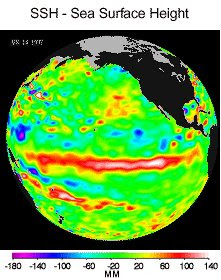
O que você prefere? Um modelo realista e complicado que não te dá intuição nenhuma sobre o que está acontecendo ou um modelo simples que não descreve quantitativamente, mas sim qualitativamente um dado fenômeno?
Este é o problema clássico que os cientistas que trabalham com simulações enfrentam. No caso do estudo dos fenômenos ligados aos oceanos - e por tabela à circulação atmosférica. Mas estes autores propõe os modelos simples como uma ferramenta de trabalho importante.
El Nino and the Delayed Action Oscillator
Authors: Ian Boutle, Richard H. S. Taylor, Rudolf A. Roemer
(Submitted on 10 Mar 2006)
Abstract: We study the dynamics of the El Nino phenomenon using the mathematical model of delayed-action oscillator (DAO). Topics such as the influence of the annual cycle, global warming, stochastic influences due to weather conditions and even off-equatorial heat-sinks can all be discussed using only modest analytical and numerical resources. Thus the DAO allows for a pedagogical introduction to the science of El Nino and La Nina while at the same time avoiding the need for large-scale computing resources normally associated with much more sophisticated coupled atmosphere-ocean general circulation models. It is an approach which is ideally suited for student projects both at high school and undergraduate level.
Comments:
13 RevTeX pages, 14 .eps figures included, submitted to the American Journal of Physics
Subjects:
Atmospheric and Oceanic Physics (physics.ao-ph); Geophysics (physics.geo-ph)
Journal reference:
American Journal of Physics 75, 15-24 (2007)
DOI:
10.1119/1.2358155
Cite as:
arXiv:physics/0603083v1 [physics.ao-ph]



Nenhum comentário:
Postar um comentário